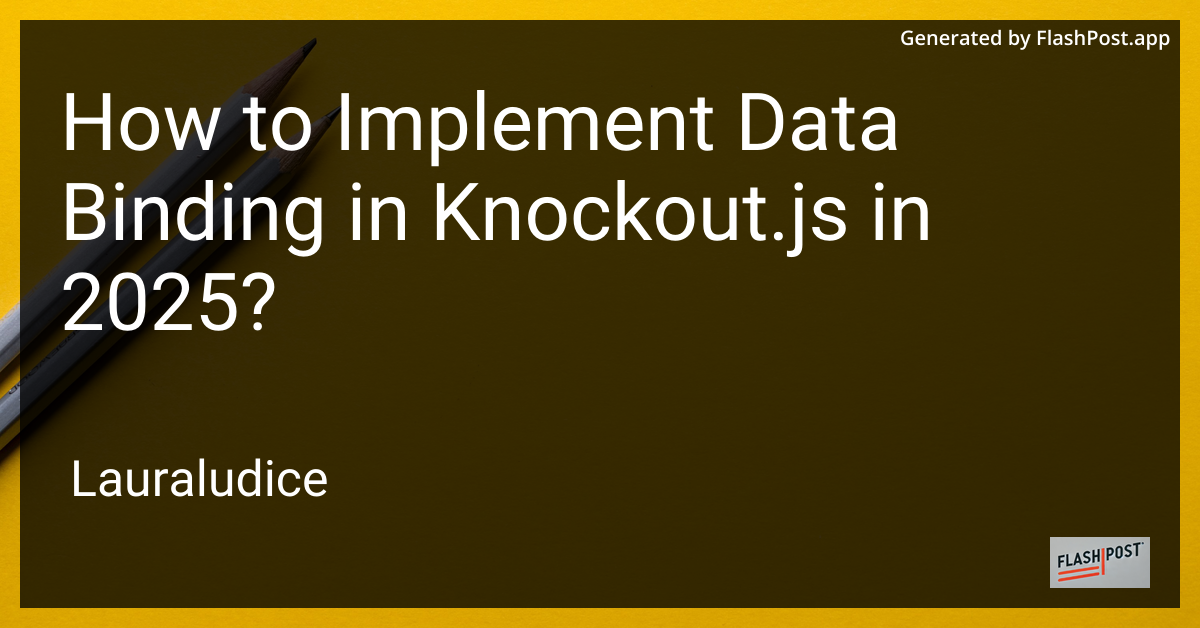
Data binding is a cornerstone of modern web application development, enabling seamless integration between the UI and the underlying data model. Knockout.js, a stand-out JavaScript library, offers a powerful and efficient data binding mechanism. In this article, we delve into implementing data binding in Knockout.js in 2025, ensuring your applications are up to date with current best practices.
Understanding Knockout.js
Knockout.js is a lightweight JavaScript library that empowers developers to build rich, responsive user interfaces with the MVVM (Model-View-ViewModel) pattern. It simplifies complex coding tasks with its easy-to-understand syntax and capabilities such as observableArrays and computed observables. Learn more about implementing knockout.js.
Setting Up Your Environment
Before diving into data binding, ensure you have Knockout.js included in your project. You can do this by loading it via a CDN:
<script src="https://cdn.jsdelivr.net/npm/knockout@latest/dist/knockout.js"></script>
Key Concepts in Knockout.js Data Binding
Observables
In Knockout.js, observables are crucial for data binding. They enable automatic updates whenever the underlying data changes.
var myObservable = ko.observable('Hello, World!');
Observable Arrays
When you're manipulating arrays, observableArray comes into play. It tracks changes to the elements and updates the UI accordingly.
var myObservableArray = ko.observableArray(['Item 1', 'Item 2', 'Item 3']);
Computed Observables
Computed observables are derived from existing observables or other computed observables. They automatically update if the dependencies change.
var myFullName = ko.computed(function() { return this.firstName() + " " + this.lastName(); }, viewModel);
Implementing Two-Way Data Binding
Two-way data binding is the ability of the UI to react to data model changes and vice versa. You can achieve this using the data-bind attribute in your HTML:
<input type="text" data-bind="value: myObservable" />
Step-by-Step Guide to Implementing Data Binding
-
Define the ViewModel: Your ViewModel should contain all observables and computed properties.
javascript function AppViewModel() { this.firstName = ko.observable('John'); this.lastName = ko.observable('Doe'); } -
Apply Bindings: Use
ko.applyBindingsto link your ViewModel with the HTML document.javascript ko.applyBindings(new AppViewModel()); -
HTML Binding Syntax: Use the
data-bindattribute to bind your ViewModel properties with your UI elements.html <input type="text" data-bind="value: firstName" /> <input type="text" data-bind="value: lastName" /> -
Handling Collections: When working with lists,
foreachbinding allows you to loop through yourobservableArray.html <ul data-bind="foreach: myObservableArray"> <li data-bind="text: $data"></li> </ul>
Advanced Tips for 2025
-
Performance Optimization: Leverage Knockout's deferred updates to improve performance by reducing unnecessary UI updates.
-
Testing Your Bindings: Ensure your bindings function correctly with robust testing strategies. Discover how to test the knockout.js click binding.
-
Integrating Business Logic: Separate your business logic from UI manipulation by structuring your ViewModel effectively. Explore where to implement business logic in knockout.js.
-
Utilizing Mapped Observable Arrays: Make full use of mapped observable arrays in scenarios like adding data, exemplified in how to append to a mapped observable array.
Conclusion
With our comprehensive guide on implementing data binding in Knockout.js in 2025, you're well-equipped to create dynamic and responsive web applications. Stay informed about best practices by exploring more about knockout.js and leverage its full potential to build robust applications.
Please ensure all external links such as knockout.js click binding and others remain valid and direct your readers appropriately.